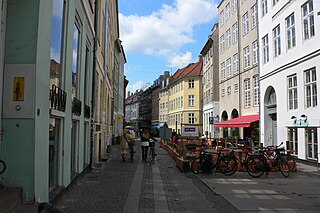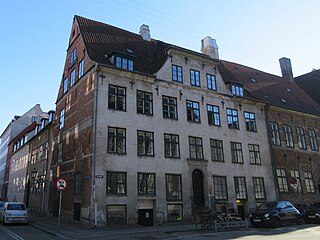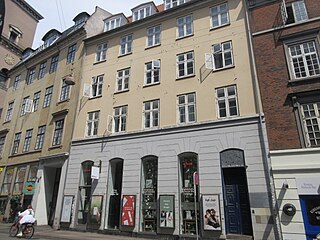
Neye, formerly Johannes Neye is a luggage manufacturer and retailer based in Copenhagen, Denmark. The company currently operates 40 retail locations selling product assortments from its own brand as well as a wide range of international brands.

Neye, formerly Johannes Neye is a luggage manufacturer and retailer based in Copenhagen, Denmark. The company currently operates 40 retail locations selling product assortments from its own brand as well as a wide range of international brands.

The company was founded when Johannes Neye opened a "galantry shop" at Vimmelskaftet 28 in 1881. [1] [2] He opened his second shop at Nygade 3 just half a year later. The company started its own production of leather products in 1891. Over the years, it acquired the entire building at No. 27, the adjacent corner building (No. 30) and two more buildings in Klosterstræde. All four buildings were replaced by a new building designed by Philip Smidth in 1915. [3]

The company was after Johannes Neye's death on 5 January 1926 continued by his son Knud Neye. The company had by then grown to seven retail locations and a leather workshop in Klosterstræde. The corner building at No. 30 was replaced by a new building in 1930–31. [2]
Knud Neye died just 59 years old from cancer on 11 February 1945. The company was after that continued by his widow Agnete Neye. The couple had no children and she therefore chose to leave the company as well as her personal wealth to a foundation, Neye Fonden, which supports research in cancer and other deceases. Agnete Neye died on 29 January 1980. [4]
The company closed its historic flagship shop at Vimmelskaftet 30 in 2017. It launched a new online platform in November that same year. [5]
Neye Since 1881 by Cecilie Toklum, a collection of bags designed by Cecilie Talkum with inspiration from historic designs from the company's archives, was launched in October 2015. [2]

The former Diocese of Odense was a Roman Catholic diocese in Denmark which included the islands of Funen, Langeland, Tåsinge, Lolland, Falster, Als, and Ærø. Its episcopal see was located in Odense at St. Canute's Cathedral.

Jorcks Passage is a passageway and associated building in central Copenhagen, Denmark. It connects the pedestrian street Strøget to Skindergade at the end of Fiolstræde.

Strædet is the colloquial name of a popular shopping and café street in the Old Town of Copenhagen, Denmark, linking Højbro Plads on Strøget at its eastern end with Regnbuepladsen next to City Hall to the west. The official street names are Læderstræde, Kompagnistræde and Farvergade. The shops along the street are generally smaller and more eclectic than the flagship stores on neighbouring Strøget. It is dominated by art galleries and antique shops. It is known for its rich gay culture with LGBT citizens, shops, bars, restaurants and coffeehouses.

The Mikkel Vibe House is a historic property located at Strandgade 32 in the Christianshavn neighbourhood of Copenhagen, Denmark. It is believed to be the oldest building in Christianshavn and takes its name after Mikkel Vibe who was mayor of Copenhagen.
Zleep Hotels is a chain of budget hotels based in Copenhagen, Denmark. It was founded in 2003 by Peter Haaber and currently is a subsidiary of H World International. The chain consists of three-star hotels located in Denmark, Sweden and Germany.
Gads Forlag, formerly G. E. C. Gad, is a publishing agent in Denmark. It is owned by G.E.C. Gads Fond, a publishing house based in Copenhagen, Denmark.

Silkegade is a minor street in the Old Town of Copenhagen, Denmark, linking busy shopping street Købmagergade in the west with Pilestræde in the east. Sparekassen Bikuben's former headquarters at No. 6–8 is listed on the Danish registry of protected buildings and places. The entrance to department store Illum's multi-storey parking facility is also located in the street.

Reventlowsgade is a street in the Vesterbro district of Copenhagen, Denmark, which follows the "Vesterbro side" of Copenhagen Central Station, between Vesterbrogade to the northwest and Tietgensgade to the southeast. One of the entrances to the Copenhagen Central Station City Circle Line metro station is located in the street. The street was refurbished in conjunction with the opening of the metro station, with new trees, seating and facilities for bicycle parking.

Louis Meyer was a Danish businessman. His company, Beckett & Meyer, a wholesale company, was after his death continued by his son Ernst Meyer.
Christian Albert Clemmensen was a Danish journalist and prolific writer of books on Danish industrial and cultural history. He was president of the Danish Union of Journalists in 1890–1899.

Klosterstræde 21 is a four-storey building in the Old Town of Copenhagen, Denmark. It has since its completion in 1817 been home to a glazier's business. The current owner, H. P. Plsem & Søn, which has been based in the building since 1938, has replaced all the windows with antique stained glass windows. The building was listed on the Danish registry of protected buildings and places in 1950.

Sabinus Theodor William Halvor Seidelin was a Danish businessman and landowner. He founded the company S. Seidelin.

Bredgade 63–65 are two identical Renaissance Revival style properties situated on Bredgade, adjacent to the small garden complex in front of Østre Landsret, in the Frederiksstaden of central Copenhagen, Denmark. Both buildings were individually listed in the Danish registry of protected buildings and places in 1988. The Mexican Embassy is based at No. 65.

Nørregade 4 is an early 19th-century property situated in Nørregade, between Frue Plads and Gammeltorv, in the Old Town of Copenhagen, Denmark. The building was listed in the Danish registry of protected buildings and places in 1945.

Rådhusstræde 10 is a complex of 18th and 19th-century buildings situated at the corner of Rådhusstræde and Vandkunsten in the Old Town of Copenhagen, Denmark. It consists of a two-storey corner building from 1750, a three-storey building in Rådhusstræde from 1851 and a rear wing from 1835. The entire complex was listed in the Danish registry of protected buildings and places in 1945.

Vodroffsvej 10 is one of several surviving 19th-century villas situated on the west side of St. Jørgen's Lake in the Frederiksberg district of central Copenhagen, Denmark. Built in 1865, it was one of three villas constructed in the area by master mason and architect Jørgen Wilhelm Frohne (1832-1909) for family members of the owner of nearby Vodroggsgård. An atelier in the garden was constructed in 1882 for the painter Laurits Tuxen, brother-in-law of the next owner and also a resident of the building. Other artists to have used the atelier include Julius Schultz, Hans Gyde Petersen and Daniel Hvidt. The house and atelier were both listed in the Danish registry of protected buildings and places in 1980. The neighboring villa at No. 8 was also constructed by Frohne and is also heritage listed. Bonnie Mürsch — a lawyer whose father purchased the house in 1940 and is herself still living in one of its three apartments — published a book about it in conjunction with its 150th anniversary in 2015.

Pilestræde 37/Kronprinsensgade 13 is an 18th-century building situated at the acute-angled corner of Pilestræde and Kronprinsensgade in the Old Town of Copenhagen, Denmark. It was listed in the Danish registry of protected buildings and places in 1945. It was constructed by the master mason and developer Johan Peter Boye Junge, who also constructed the buildings at Pilestræde 39–47 in conjunction with his creation of the street Kronprinsensgade, and who was himself a resident of the building from its completion in 1786. Other notable former residents include actors Michael and Johanne Rosing, printer Andreas Flinch, poet Christian Winther and Bing & Grøndahl co-founder Meyer Herman Bing.

Hans Wassard was a Danish merchant, landowner and one of Copenhagen's 32 Men. He invested in a number of privateer ships during the Gunboat War. He owned Marienlyst Manor at Vordingborg.

The Tutein House is a Neoclassical former bourgeois townhouse situated at the corner of Vimmelskaftet and Badstuestræde, on the pedestrianized shopping street Strøget, in central Copenhagen, Denmark. The building was constructed by Johan Martin Quist for Friederich Tutein in 1800–01. The building was adaptedand extended in 1881 by Reinholdt W. Jorck for whom Horcks Passage on the other side of the street would later also be constructed. Café Bernina—Cpåenhagen's leading literary coffee house in the late 19th century—opened in the building in October 1881. Kjøbenhavns Telefon-Selskab's first central office was also based in the building from 1881 to 1895. The building is still owned by Jorcks Ejendomme, a property company established by Reinholdt W. Jorck's son Georg Jorck and now owned by two charitable foundations created by him. The tenants include the newspaper Kristeligt Dagblad.

Købmagergade 36/Kronprinsensgade 1 is a Neoclassical building situated at the corner of the shopping street Købmagergade and Kronprinsensgade in central Copenhagen, Denmark. Constructed for dorector of the Royal Greenland Trade Department Hartvig Marcus Frisch in 1795, some ten years after Kronprinsessegade was established at private initiative by Johan Peter Boye Junge, a master builder and head of Copenhagen Fire Corps, it was shortly thereafter sold to the wealthy widow Cecilie Rosted, who kept it until her death. From 1826 to 2003, it was then home to the Royal Military and Vajsenhus Pharmacy. The pharmacy is now located at nearby Landemærket 1–3. Other notable former residents of the building include the painter Vilhelm Groth.